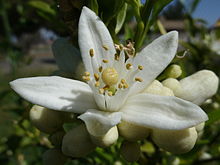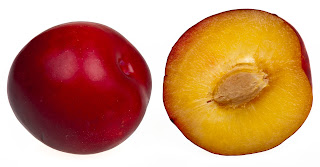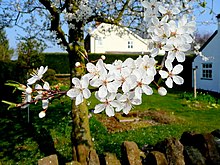The fruit of the
Citrus × sinensis is considered a sweet orange, whereas the fruit of the
Citrus × aurantium is considered a
bitter orange. The sweet orange reproduces asexually (
apomixis through
nucellar embryony); varieties of sweet orange arise through mutations.
[3]
The orange is a
hybrid, between
pomelo (
Citrus maxima) and
mandarin (
Citrus reticulata). It has genes that are ~25% pomelo and ~75% mandarin;
[3][4] however, it is not a simple
backcrossed BC1 hybrid, but hybridized over multiple generations.
[5] The chloroplast genes, and therefore the maternal line, seem to be pomelo.
[3] The sweet orange has had its full genome sequenced.
[3] Earlier estimates of the percentage of pomelo genes varying from ~50% to 6% have been reported.
[4]
Sweet oranges were mentioned in Chinese literature in 314 BC.
[3] As of 1987, orange trees were found to be the most
cultivated fruit tree in the world.
[6] Orange trees are widely grown in tropical and subtropical climates for their sweet fruit. The fruit of the orange tree can be eaten fresh, or processed for its juice or fragrant peel.
[7] As of 2012, sweet oranges accounted for approximately 70% of citrus production.
[8]
In 2013, 71.4 million metric tons of oranges were grown worldwide, production being highest in
Braziland the U.S. states of
Florida and
California.
[9]
Botanical information and terminology

Orange blossoms and oranges on tree
All
citrus trees belong to the single
genus Citrus and remain almost entirely
interfertile. This means that there is only one
superspecies that includes
grapefruits,
lemons,
limes, oranges, and various other types and
hybrids.
[10] As the interfertility of oranges and other citrus has produced numerous hybrids, bud unions, and
cultivars, their
taxonomy is fairly controversial, confusing or inconsistent.
[8][11] The fruit of any citrus tree is considered a
hesperidium (a kind of modified
berry) because it has numerous
seeds, is fleshy and soft, derives from a single
ovary and is covered by a
rind originated by a rugged thickening of the
ovary wall.
[12][13]
Different names have been given to the many varieties of the genus.
Orange applies primarily to the sweet orange –
Citrus sinensis (
L.)
Osbeck. The orange tree is an
evergreen,
flowering tree, with an average height of 9 to 10 m (30 to 33 ft), although some very old specimens can reach 15 m (49 ft).
[14]Its oval
leaves,
alternately arranged, are 4 to 10 cm (1.6 to 3.9 in) long and have
crenulate margins.
[15]Although the sweet orange presents different sizes and shapes varying from spherical to oblong, it generally has ten segments (
carpels) inside, and contains up to six seeds (or
pips)
[16] and a porous white tissue – called
pith or, more properly,
mesocarp or albedo—lines its rind.
[17] When unripe, the fruit is green. The grainy irregular rind of the ripe fruit can range from bright orange to yellow-orange, but frequently retains green patches or, under warm climate conditions, remains entirely green. Like all other citrus fruits, the sweet orange is non-
climacteric. The
Citrus sinensis is subdivided into four classes with distinct characteristics: common oranges, blood or pigmented oranges, navel oranges, and acidless oranges.
[18][19][20]
Other citrus groups also known as oranges are:
- Bitter orange (Citrus aurantium), also known as Seville orange, sour orange (especially when used as rootstock for a sweet orange tree), bigarade orange and marmalade orange. Like the sweet orange, it is a pomelo x mandarin hybrid.[21]
- Bergamot orange (Citrus bergamia Risso), grown mainly in Italy for its peel, producing a primary essence for perfumes, also used to flavorEarl Grey tea. It is a hybrid, probably bitter orange x limetta.[22]
- Trifoliate orange (Poncirus trifoliata), sometimes included in the genus (classified as Citrus trifoliata). It often serves as a rootstock for sweet orange trees and other Citrus cultivars.[23]
- Mandarin orange (Citrus reticulata) is an original species of citrus, and is a progenitor of the common orange.
An enormous number of cultivars have, like the sweet orange, a mix of pomelo and mandarin ancestry. Some cultivars are mandarin-pomelo hybrids, bred from the same parents as the sweet orange (e.g. the
tangor and
ponkan tangerine). Other cultivars are sweet orange x mandarin hybrids (e.g.
clementines).
Mandarin traits generally include being smaller and oblate, easier to peel, and less acidic.
[24] Pomelotraits include a thick white albedo (rind pith, mesocarp) that is more closely attached to the segments.
Orange trees generally are
grafted. The bottom of the tree, including the roots and trunk, is called rootstock, while the fruit-bearing top has two different names:
budwood (when referring to the process of grafting) and
scion (when mentioning the variety of orange).
[25]
Etymology
Main article:
Orange (word)

A cluster of orange blossoms.
The word entered
Late Middle English in the fourteenth century via
Old French orenge (in the phrase
pomme d'orenge).
[27] The French word, in turn, comes from
Old Provençal auranja, based on Arabic
nāranj.
[26] In several languages, the initial
n present in earlier forms of the word dropped off because it may have been mistaken as part of an indefinite article ending in an
n sound—in French, for example,
une norenge may have been heard as
une orenge. This linguistic change is called
juncture loss.
The color was named after the fruit,
[28] and the first recorded use of
orange as a color name in English was in 1512.
[29][30]

A closeup of an orange blossom.
As
Portuguese merchants were presumably the first to introduce the sweet orange in Europe, in several modern
Indo-European languages the fruit has been named after them. Some examples are Albanian
portokall, Bulgarian
портокал (
portokal), Greek
πορτοκάλι (
portokali),
Macedonian portokal, Persian
پرتقال (
porteghal), and Romanian
portocală.
[31][32] Related names can be found in other languages, such as Arabic
البرتقال (
bourtouqal),
Georgian ფორთოხალი (
p'ort'oxali), Turkish
portakal and
Amharicbirtukan.
[31] Also, in
southern Italian dialects (e.g.
Neapolitan), an orange is
portogallo or
purtuallo, literally "(the) Portuguese (one)", in contrast to
standard Italian arancia.
In other Indo-European languages, the words for
orange allude to the eastern origin of the fruit and can be translated literally as "apple from China". Some examples are
Low German Apfelsine, Dutch
appelsien and
sinaasappel, Swedish
apelsin, and Norwegian
appelsin.
[32] A similar case is
Puerto Rican Spanish china.
[33][34]
Various
Slavic languages use the variants
pomaranč (Slovak),
pomeranč (Czech),
pomaranča(Slovene), and
pomarańcza (Polish), all the from Old French
pomme d'orenge.
[35][36]












